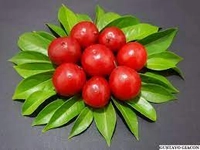Ubaia Live fruit plant (Eugenia patrisii)
Product description
Eugenia patrisii, commonly known as Ubaia or Uvaia, is a tropical fruit-bearing tree native to Brazil. This fruit is not widely known outside of its native region but is highly regarded locally for its unique flavor and versatility. Here is a description of the Ubaia (Eugenia patrisii) plant:
-
Tree Appearance: Ubaia trees are small to medium-sized evergreen trees that typically reach heights of 3 to 10 meters (10 to 33 feet). They have a dense, rounded canopy with lush, dark green foliage.
-
Leaves: The leaves of the Ubaia tree are simple, elliptical to oblong in shape, and arranged alternately along the branches. They are typically dark green, glossy, and have a leathery texture.
-
Flowers: Ubaia trees produce small, fragrant, and attractive flowers that are typically white or cream-colored. These flowers are typically hermaphroditic, containing both male and female reproductive parts, and are pollinated by insects.
-
Fruit: The Ubaia fruit is the most significant feature of this tree. It is a small, round to slightly oval berry, typically measuring around 1-2 centimeters (0.4-0.8 inches) in diameter. The fruit's skin is thin and smooth, and it can range in color from green to yellow when ripe. The flesh inside is juicy, aromatic, and has a sweet and slightly tart flavor. It is often eaten fresh, and the taste is often described as a combination of apple, pineapple, and citrus.
-
Seeds: Inside the fruit, there are typically one to several small, flattened seeds that are usually discarded when consuming the flesh.
-
Habitat: Ubaia trees are native to tropical rainforests and are typically found in lowland and submontane areas of Brazil.
-
Cultivation: These trees are cultivated for their fruit and are grown in regions with a tropical or subtropical climate. They prefer well-draining, slightly acidic soils and require regular watering. Propagation is often done from seeds or cuttings.
-
Uses: Ubaia fruit is primarily consumed fresh. It is enjoyed for its unique and refreshing flavor, making it a popular choice for eating out of hand or using in a variety of culinary applications. The fruit can be used in jams, jellies, desserts, and beverages. It is rich in vitamins and antioxidants, making it a nutritious addition to the diet.
Ubaia is a lesser-known tropical fruit that is highly valued in its native Brazil. While it may not be as widely recognized as some other tropical fruits, its distinctive taste and versatility make it a cherished ingredient in regional cuisine and a favorite among those who have the opportunity to taste it.
✦
You might like these
✦







